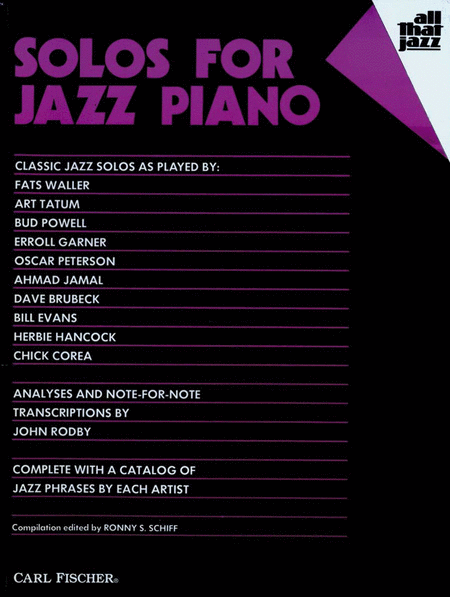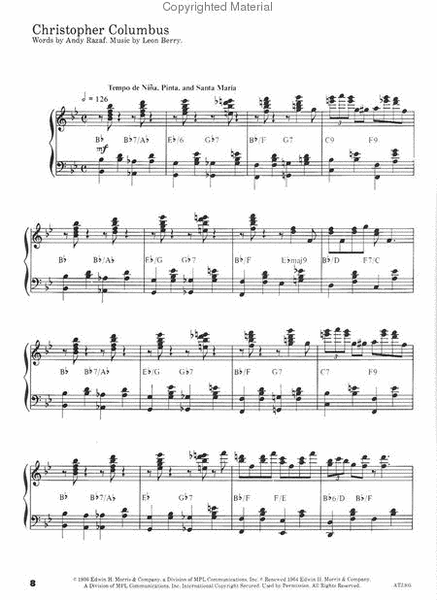Solos for Jazz Piano
-
Ships in 1 to 2 weeks
Details
Description
SKU: CF.ATJ305
Composed by Bud Powell, Chick Corea, Don Raye, George Gershwin, Herbie Hancock, Hoagy Carmichael, Jerome Kern, Leon Berry, Margarita Lecuona, Miles Davis, and Pat Johnston. Edited by Ronny Schiff. Arranged by Ahmad Jamal, Art Tatum, Bill Evans, Dave Brubeck, Erroll Garner, Oscar Peterson, and Thomas "Fats" Waller. SWS. Collection. With Standard notation. 64 pages. Carl Fischer Music #ATJ305. Published by Carl Fischer Music (CF.ATJ305).ISBN 9780825803987. UPC: 798408003982. 9 X 12 inches. Text: Stuart Gorrell; Don Raye; Pat Johnston; Oscar Hammerstein II; Ira Gershwin; Ansy Razaf, transcribed by John Rodby. Stuart Gorrell, Don Raye, Oscar Hammerstein, Pat Johnston, Ansy Razaf, Ira Gershwin.
Contains classic jazz solos as played by Fats Waller, Art Tatum, Bud Powell, Erroll Garner, Oscar Peterson, Ahmad Jamal, Dave Brubeck, Bill Evans, Herbie Hancock, and Chick Corea. Includes analyses and note-for-note transcriptions by John Rodby with a catalog of jazz phrases by each artist.
The best way to view the wide range of styles presented in this collection is to follow the evolution of jazz piano from the early 1900s to now.Scott Joplin is considered the first major jazz composer. In the late 1890's he adapted the left-hand piano techniques of composers such as Schubert, Chopin, and Liszt, plus European compositional forms like the waltz and march. To these established elements he added Afro-American syncopated rhythms and blues-like "bent" notes, creating a piano style called ragtime.Jelly Roll Morton, James P. Johnson, and Johnson's gifted pupil Fats Waller are noted for developing the stride piano style early in this century. In this style, the left hand usually played octaves, tenths, or fifths on beats two and four. They introduced more complex chords (9ths and 13ths) and riffs, and chromatic runs became part of improvisation.Eventually blues and boogie elements were also incorporated into jazz, resulting in the new robust style of the'30s, swing. During that decade, Earl Hines' innovative improvisations, which imitated saxophone or trumpet lines, influenced many musicians. Likewise, Duke Ellington's unique melodic and harmonic ideas such as chromatically altered chord tones (b5, #5, b9, #9, #11, b13, a clear legacy of Debussy, Ravel and Gershwin), revolutionized jazz as played on the piano, as well as other instruments. Other noted pianists contributing to the swing style were Teddy Wilson, Count Basie, and Nat "King" Cole.When Art Tatum came along he literally "summarized" piano playing, using everything that had evolved since Joplin. A true virtuoso, Tatum has influenced generations of instrumental musicians, and not only pianists. Impeccable sense of pulse, intricate, long improvised lines, tall chromatically-altered chords, and syncopated left-hand figures make him the unsurpassed giant of jazz piano playing. Tatum undoubtedly paved the way toward the new style of the 40s, be-bop.Milt Buckner's "orchestral" piano playing, the block chord or locked hand style, became known through George Shearing's work. Errol Garner mixed ragtime, stride, swing and early bebop ideas with an innovative left hand approach in which a bass note and chord simultaneously sounded, imitating bass and guitar, creating his highly individual style.Ensemble playing was also in transition by the '40s. More and more, bass players abandoned the old way of playing the root and fifth of the chords, and instead began using passing and neighboring notes between chord tones - the "walking bass". Pianists then had to stay out of the way of basslines by either playing roots and sevenths (thinner structures), or modified chord structures imitating the trombones sections of big bands.Charlie Parker, Dizzy Gillespie and Thelonious Monk were responsible for the evolution of be-bop. Adding walking bass to complex, long irregular melodic lines, highly technical improvisations became the norm for horn players, and pianist Bud Powell was inspired to apply those kind of horn lines to piano with lightning results.In the late '40s, a more relaxed, quieter manner of jazz - cool jazz - came about. George Shearing, Lenny Tristano, and The Modern Jazz Quartet represented this style, a counterbalance to the very frenetic sound of bebop.During the '50s, jazz styles began fragmenting into subgroups such as: hard bop - Horace Silver; progressive jazz - Dave Brubeck, who incorporated such 20th century compositional devices as polytonality and asymmetrical meters of 3/4, 5/4, 7/8, and "funk jazz", which revived the gospel and blues tradition and the joyous drive and feel of jazz associated with it - Hampton Hawes and Oscar Peterson are representative of this style. Peterson, a pianistic giant like Art Tatum, also should be noted as another "summarizing" force in jazz piano, equally at home in all styles from stride to swing, be-bop to funk and Latin; as a matter of fact, almost anything else possible on the piano.When, by the '60s, transcribed solos of earlier greats became more readily available to study, post-bop pianists often returned to some aspects of earlier styles, while adding their own particular gift. Ahmad Jamal, McCoy Tyner, Tommy Flanagan, and Red Garland are among these.Bill Evans' cool, intelligent style used impressionistic harmonies, unusual irregular phrases overlapping barlines, and a chamber music-like distribution of material between piano, bass and drums, creating another school of musical thought.As a reaction to the over-harmonized be-bop, post-bop thinking, Miles Davis and John Coltrane pioneered the movement toward the use of modes as a basis for improvising, often on one chord for several bars. Modal jazz is characterized by angular lines, irregular phrasing, unresolved dissonances, and the melodic use of 4ths, 5ths consecutively.Chick Corea and Herbie Hancock also applied this Bartókian approach to the piano very ingeniously. In addition, they, and many other pianists today, are also discovering that certain orchestral effects and techniques are more effective on electronic keyboards. Consequently, today's keyboardist has a whole range of options, whether to play acoustic or electronic keyboards, utilize more traditional techniques or modern compositional devices such as Schoenberg's 12-tone approach, or to use a combination of several different style periods to express his or her creativity in a uniquely personal way.This collection of piano improvisational solos provides the serious musician/student with a valuable overview of jazz piano techniques, from the 1920s to the 1980s. The detailed study of improvised materials from Fats Waller to Chick Corea not only enhances pianistic development, but illustrates the historical development of jazz music as well.
About SMP Level 8 (Early Advanced)
![]()
4 and 5-note chords spanning more than an octave. Intricate rhythms and melodies.
Song List (12)
- Introduction
- Christopher Columbus [Arranged by Fats Waller, Text by Andy Razaf]
- The Man I Love [Arranged by Art Tatum, Text by Ira Gershwin]
- Un Poco Loco
- I'll Remember April [Arranged by Erroll Garner, Text by Don Raye; Pat Johnston]
- All the Things You Are [Arranged by Oscar Peterson, Text by Oscar Hammerstein Ii]
- Taboo [Arranged by Ahmad Jamal]
- Georgia on My Mind [Arranged by Dave Brubeck, Text by Stuart Gorrell]
- Nardis [Arranged by Bill Evans]
- Textures
- Spain
- Catalogue of Phrases on V-I and II-V-I Progressions


 Share
Share